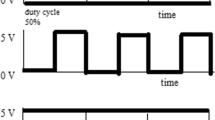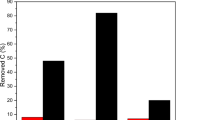Abstract
A proposal for scaling-up the photocatalytic reactors is described and applied to the coated catalytic walls with a thin layer of titanium dioxide under the near ultraviolet (UV) irradiation. In this context, the photocatalytic degradation of isovaleraldehyde in gas phase is studied. In fact, the removal capacity is compared at different continuous reactors: a photocatalytic cylindrical reactor, planar reactor, and pilot unit. Results show that laboratory results can be useful for reactor design and scale-up. The flowrate increases lead to the removal capacity increases also. For example, with pilot unit, when flowrate extends four times, the degradation rate varies from 0.14 to 0.38 g h−1 mcat −2. The influence of UV intensity is also studied. When this parameter increases, zboth degradation rate and overall mineralization are enhanced. Moreover, the effects of inlet concentration, flowrate, geometries, and size of reactors on the removal capacity are also studied.












Similar content being viewed by others
References
ADEME (2005) Pollutions olfactives: origine, législation, analyse, traitement. Ademe, Dunod, Angers
Ahlstrom Patent EP 1069950 (2000). AU 735798 US 09/467, 650; JP 2000-542104
Assadi AA, Bouzaza A, Wolbert D (2012) Photocatalytic oxidation of trimethylamine and isovaleraldehyde in an annular reactor: influence of the mass transfer and the relative humidity. J Photochem Photobiol A Chem 236:61–69
Assadi AA, Palau J, Bouzaza A, Wolbert D (2013) A continuous air reactor for photocatalytic degradation of isovaleraldehyde: effect of different operating parameters and chemical degradation pathway. Chem Eng Res Des 91:1307–1316
Bayarri B, Giménez J, Maldonado MI, Malato S, Esplugas S (2013) 2,4-dichlorophenol degradation by means of heterogeneous photocatalysis. Comparison between laboratory and pilot plant performance. Chem Eng J 232:405–417
Boulinguiez B, Bouzaza A, Merabet S, Wolbert D (2008) Photocatalytic degradation of ammonia and butyric acid in plug-flow reactor: degradation kinetic modeling with contribution of mass transfer. J Photochem Photobiol A Chem 200:254–261
Bouzaza A, Vallet C, Laplanche A (2006) Photocatalytic degradation of some VOCs in the gas phase using an annular flow reactor—determination of the contribution of mass transfer and chemical reaction steps in the photo-degradation process. J Photochem Photobiol A Chem 177:212–217
Brosillon S, Lhomme L, Vallet C, Bouzaza A, Wolbert D (2008) Gas phase photocatalysis and liquid phase photocatalysis: interdependence and influence of substrate concentration and photon flow on degradation reaction kinetics. Appl Catal B Environ 78:232–241
Chen D, Ray AK (2001) Removal of toxic metal ions from wastewater by semiconductor photocatalysis. Chem Eng Sci 56(4):1561–1570
Davezza M, Fabbri D, Bianco Prevot A, Pramauro E (2011) Removal of alkylphenols from polluted sites using surfactant-assisted soil washing and photocatalysis. Environ Sci Pollut Res 18:783–789
Debono O, Thevenet F, Gravejat P, Hequet V, Raillard C, Lecoq L, Locoge N (2011) Toluene photocatalytic oxidation at ppbv levels: kinetic investigation and carbon balance determination. Appl Catal B Environ 106:600–608
Guaitella O, Thevenet F, Puzenat E, Guillard C, Rousseau A (2008) C2H2 oxidation by plasma/TiO2 combination: influence of the porosity, and photocatalytic mechanisms under plasma exposure. Appl Catal B Environ 80:296–305
Herrmann J-M (2010) Photocatalysis fundamentals revisited to avoid several misconceptions. Appl Catal B Environ 99(3–4):461–468
Hunger M, Husken G, Brouwers H J-H (2010) Photocatalytic degradation of air pollutants-modeling to large scale application. Cement Concrete Res 40:313–320
Imoberdorf GE, Irazoqui HA, Alfano OM, Cassano AE (2007) Scaling-up from first principles of a photocatalytic reactor for air pollution remediation. Chem Eng Sci 62:793–804
International Programme on Chemical Safety, Canadian Centre for Occupational Health and Safety (CCOHS) (2004) OECD Screening information-3-methyl butanal. UNEP, International Register of Potentially Toxic Chemicals (IRPTC)
Jovic F, Kosar V, Tomasic V, Gomzi Z (2012) Non-ideal flow in an annular photocatalytic reactor. Chem Eng Res Des 90:1297–1306
Kim SB, Hwang HT, Hong SC (2002) Photocatalytic degradation of volatile organic compounds at the gas–solid interface of a TiO2 photocatalyst. Chemosphere 48:437–444
Lacombe S, Keller N (2012) Photocatalysis: fundamentals and applications in JEP 2011. Environ Sci Pollut Res 19:3651–3654
Li G, Zhang Z, Sun H, Chen J, An T, Li B (2013) Pollution profiles, health risk of VOCs and biohazards emitted from municipal solid waste transfer station and elimination by an integrated biological-photocatalytic flow system: a pilot-scale investigation. J Hazard Mater 250:147–154
Maciuca A, Batiot-Dupeyrat C, Tatibouët J-M (2012) Synergetic effect by coupling photocatalysis with plasma for low VOCs concentration removal from air. Appl Catal B Environ 125:432–438
Nicolella C, Rovatti M (1998) Mathematical modeling of monolith reactors for photocatalytic oxidation of air contaminants. Chem Eng J 69:119–126
Palau J, Penya-Roja JM, Gabaldón C, Álvarez-Hornos FJ, Sempere F, Martínez-Soria V (2011) UV photocatalytic oxidation of paint solvent compounds in air using an annular TiO2-supported reactor. J Chem Technol Biotechnol 86:273–328
Passalía C, Alfano OM, Brandi RJ (2012) A methodology for modeling photocatalytic reactors for indoor pollution control using previously estimated kinetic parameters. J Hazard Mater 211–212:357–365
Petit N, Bouzaza A, Wolbert D, Petit P, Dussaud J (2007) Photocatalytic degradation of gaseous perchloroethylene in continuous flow reactors: rate enhancement by chlorine radicals. Catal Today 124:266–272
Prieto-Rodriguez L, Miralles-Cuevas S, Oller I, Fernández-Ibánez P, Agüera A, Blanco J, Malato S (2012) Optimization of mild solar TiO2 photocatalysis as a tertiary treatment for municipal wastewater treatment plant effluents. Appl Catal B Environ 128:119–125
Salvadó-Estivill I, Brucato A, Puma GL (2007) Two-dimensional modeling of a flat-plate photocatalytic reactor for oxidation of indoor air pollutants. Ind Eng Chem Res 46:7489–7496
Tomasic V, Jovic F, Gomzi Z (2008) Photocatalytic oxidation of toluene in the gas phase: modeling an annular photocatalytic reactor. Catal Today 137:350–356
United States Environmental Protection Agency (1998) EPA-456/F-98–005
Vallet C (2006) Application de la photocatalyse à l’élimination des odeurs en élevages porcins. Thèse No. 3358. Rennes: ENSC Rennes, 149 p
Vincent G, Schaer E, Marquaire P-M, Zahraa O (2011) CFD modelling of an annular reactor, application to the photocatalytic degradation of acetone. Process Saf Environ Prot 89:35–40
Wang S, Ang HM, Tade MO (2007) Volatile organic compounds in indoor environment and photocatalytic oxidation: state of the art. Environ Int 33:694–705
Zhang Y, Yang R, Zhao R (2003) A model for analyzing the performance of photocatalytic air cleaner in removing volatile organic compounds. Atmos Environ 37:3395–3399
Zhong L, Haghighat F, Blondeau P, Kozinski J (2010) Modeling and physical interpretation of photocatalytic oxidation efficiency in indoor air applications. Build Environ 45:2689–2697
Acknowledgement
The authors thank the support from the French National Research Agency. The authors also thank the Ahlstrom Company for supplying the photocatalytic medium.
Author information
Authors and Affiliations
Corresponding author
Additional information
Responsible editor: Angeles Blanco
Rights and permissions
About this article
Cite this article
Assadi, A.A., Bouzaza, A., Wolbert, D. et al. Isovaleraldehyde elimination by UV/TiO2 photocatalysis: comparative study of the process at different reactors configurations and scales. Environ Sci Pollut Res 21, 11178–11188 (2014). https://doi.org/10.1007/s11356-014-2603-7
Received:
Accepted:
Published:
Issue Date:
DOI: https://doi.org/10.1007/s11356-014-2603-7




